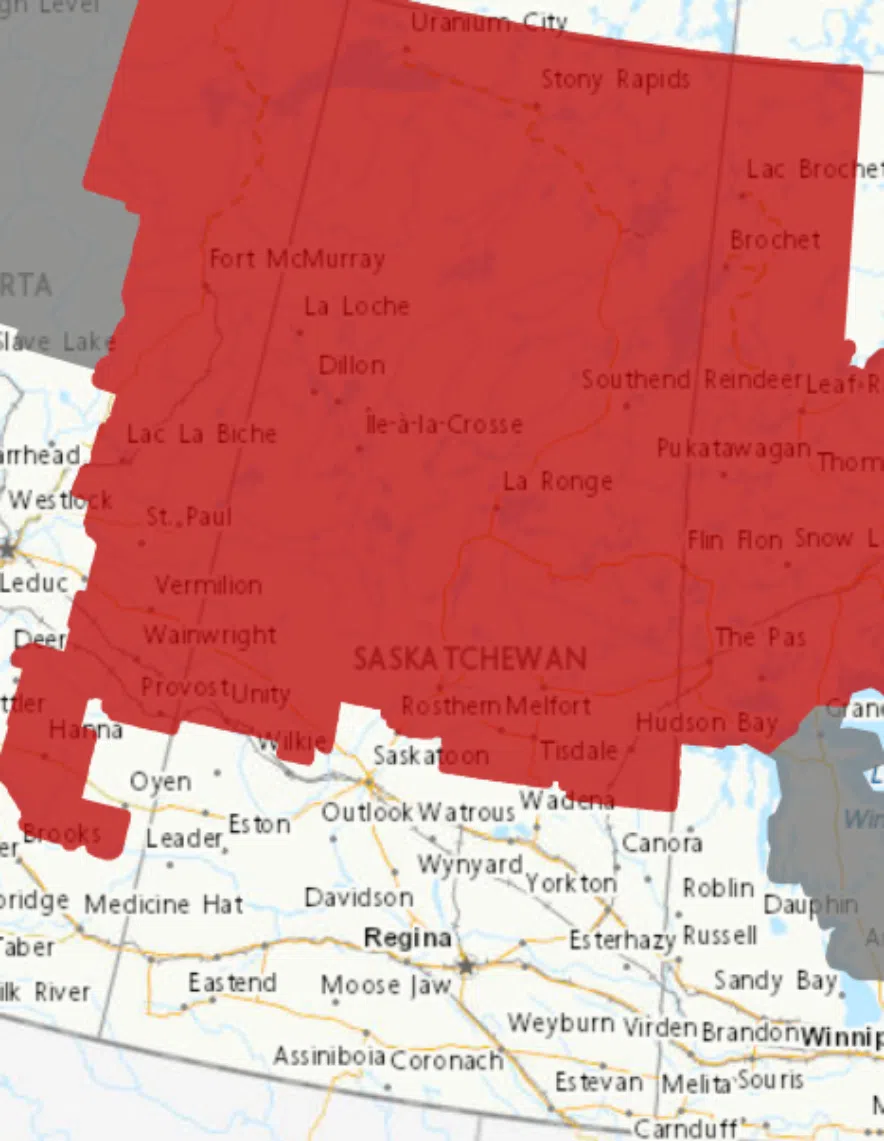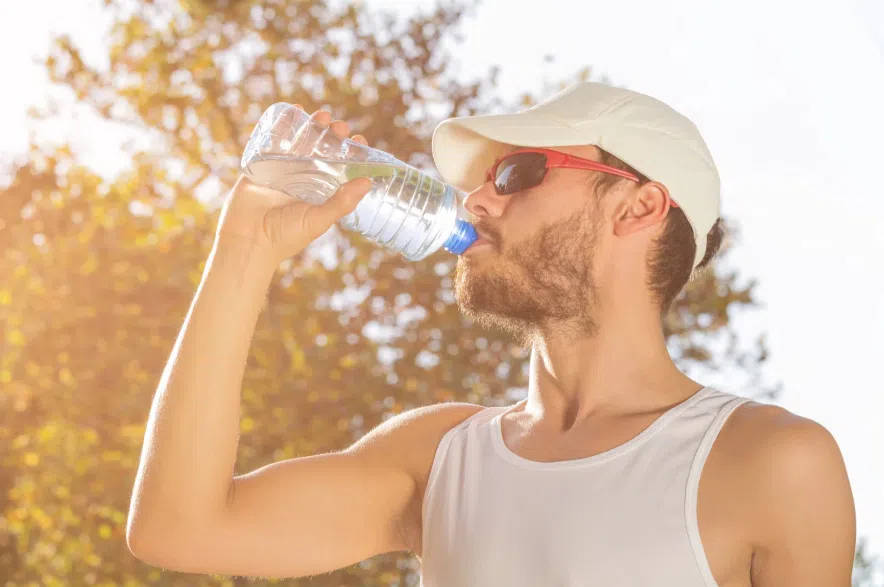Environment Canada on Sunday issued more air quality and heat warnings for a large area of northern and central part of Saskatchewan.
The weather agency said daytime high temperatures on Sunday would be near 30 C or more, but are expected to moderate on Monday and Tuesday.
Read more:
- Irene Scherban: Missing Saskatchewan teen ‘not forgotten’ 50 years later, says RCMP
- Saskatchewan farmer says recent rain brought new weed problem
The heat warnings cover cities like Lloydminster, Prince Albert and the Battlefords, as well as areas like Beauval, Prince Albert National Park, Lac La Ronge, La Loche and Beauval, where firefighters are battling to contain wildfires.
Air quality of 10+ is also predicted for many northern areas.
More information on air quality alerts for specific areas of the province is available at weather.gc.ca. Information is also available on the Saskatchewan Public Service Agency website at saskpublicsafety.ca and the SaskAlert app.
Environment Canada’s air quality index can be found here.
You can take a look at the ratings in communities across your province or territory.
A rating of 1-3 is low risk, 4-6 is moderate risk, 7-10 is high risk and over 10 is very high risk.
The risk designations can change regularly in the same community, Environment Canada says, so it’s important to keep checking the air quality forecast.
The hot temperatures, which will feel hotter because of high humidity, bring with them a risk of heatstroke and heat exhaustion.

The area covered by heat and air quality warnings in Saskatchewan on Aug. 3, 2025. (Environment Canada)
What is heatstroke?
The Saskatchewan Health Authority (SHA) says classic heatstroke can develop without exertion when a person is exposed to a hot environment and the body is unable to cool itself effectively. The body’s ability to sweat and transfer the heat to the environment is reduced. and a person with heatstroke may stop sweating.
Classic heatstroke may develop over several days, and babies, older adults, and people with chronic health problems are at the greatest risk.
Exertional heatstroke may develop when a person is working or exercising in a hot environment. A person with heatstroke from exertion may sweat profusely, but the body still produces more heat than it can lose. This causes the body’s temperature to rise.
What are the symptoms of heatstroke?
“These people have altered levels of consciousness. They’re dizzy, they’re confused, they’re maybe going in and out of consciousness and they’ve stopped sweating,” family physician Dr. Carla Holinaty told 980 CJME in 2023.
“They just don’t have that capacity anymore and now their skin is dry.”
What can I do about heatstroke?
Heatstroke is a medical emergency and people should call 9-1-1 as soon as they notice someone showing signs of heatstroke.
After calling for help, Holinaty said it’s important to cool the afflicted person down by moving them to a cool, shady place or using cold, wet towels to lower their body temperature.
“I wouldn’t be trying to get them to drink a whole lot of liquid, especially if they’re quite confused or kind of coming in and out of consciousness, because we don’t want them to choke,” she said.
What about heat exhaustion?
Heat exhaustion is milder than heat stroke.
“We tend to see people get headaches or muscle cramps. Sometimes they get nauseous. Sometimes they might feel a little bit dizzy or weak,” Holinaty said. “Their body temperature is not so high that it’s dangerous.”
The SHA says heat exhaustion occurs when you can’t sweat enough to cool your body. It can develop when you work or exercise in hot weather and don’t drink enough liquids to replace the fluids you lose from sweating a lot. Heat exhaustion can be caused by loss of fluid (dehydration) or loss of electrolytes.
Symptoms of heat exhaustion include fatigue, weakness, headache, dizziness, and nausea. Also, the skin is pale, cool, and moist.
Mild heat exhaustion may sometimes cause fainting but it doesn’t cause a change in your mental alertness and usually can be treated at home.
What other conditions can be cause by hot temperatures?
SHA says that heat-related illnesses include:
- Heat rash (prickly heat) that happens when the sweat ducts to the skin become blocked or swell, causing discomfort and itching.
- Heat cramps, which can occur in muscles during and after exercise because sweating caused the body to lose water, salt, and minerals (electrolytes).
- Heat edema — swelling in the legs and hands that can happen when you sit or stand for a long time in the heat.
- Heat tetany (hyperventilation and heat stress), which is usually caused by short periods of stress in a hot environment.
- Heat syncope (fainting) brought about by low blood pressure when heat causes the blood vessels to expand (dilate). Then body fluids move into the legs because of gravity.
Take action to protect yourself and others – extreme heat can affect everyone’s health. Determine if you or others around you are at greater risk of heat illness. Check on older adults, those living alone and other at-risk people in-person or on the phone multiple times a day.
Watch for the early signs of heat exhaustion in yourself and others. Signs may include headache, nausea, dizziness, thirst, dark urine and intense fatigue. Stop your activity and drink water.
Heat stroke is a medical emergency. Call 9-1-1 or your emergency health provider if you, or someone around you, is showing signs of heat stroke which can include red and hot skin, dizziness, nausea, confusion and change in consciousness. While you wait for medical attention, try to cool the person by moving them to a cool place, removing extra clothing, applying cold water or ice packs around the body.
Tips to beat the heat
- Drink water often and before you feel thirsty to replace fluids.
- Close blinds, or shades and open windows if outside is cooler than inside.
- Turn on air conditioning, use a fan, or move to a cooler area of your living space. If your living space is hot, move to a cool public space such as a cooling centre, community centre, library or shaded park.
- Follow the advice of your region’s public health authority.
- Plan and schedule outdoor activities during the coolest parts of the day.
- Limit direct exposure to the sun and heat. Wear lightweight, light-coloured, loose-fitting clothing and a wide-brimmed hat.
- Never leave people, especially children, or pets inside a parked vehicle. Check the vehicle before locking to make sure no one is left behind.
- When there is an extreme heat event occurring with wildfire smoke, prioritize keeping cool.
- Call HealthLine 811 for advice on health risks, symptoms and precautions associated with heat.
Read more:











